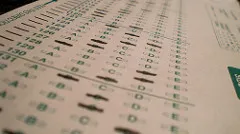For undergraduates planning to earn advanced degrees, standardized tests are a crucial aspect of the admissions cycle. Across Stanford’s campus, in between juggling classes and extracurricular activities, students use different methods to prepare for whichever test they are planning to take, with some choosing to attend test preparation courses and others studying independently.
Melody Rodríguez ’19, who took the Law School Admission Test (LSAT) in September, chose not to attend test preparation courses because she found that self-studying using a book containing practice activities and tests fit more easily into her schedule.
“I think in an ideal world, I would have maybe taken a course, but it’s hard to have school during the year, work a job during the summer and find time to study for the LSAT on top of that,” Rodríguez said.
Rodríguez also utilized advising services offered by Undergraduate Advising and Research (UAR) for students preparing for the LSAT and the MCAT. She said that Kathryn Wright, UAR’s pre-law advisor, recommended that Rodríguez only sign up for a commercial test preparation course if her scores had not improved after taking multiple practice tests. However, Wright’s recommendations vary by student.
“Preparation for these tests may be student-specific, so we do recommend that pre-med and pre-law students meet with a UAR pre-professional advisor for a discussion of specific, individualized recommendations,” wrote Katie Wang, Director of Upper Division Advising and Pre-Professional Programs at UAR, in an email to The Daily.
Wang advised students preparing for the two tests to visit UAR’s website for additional resources.
Austin Su ’19 chose to forgo UAR’s advising services but found that using test preparation books gave him the flexibility to address areas of weakness at his own pace while preparing for this past January’s Medical College Admission Test (MCAT).
“I think what it’s really about, especially for the MCAT, is identifying the parts that you feel really uncomfortable with and hitting those a lot harder,” Su said. “You can only do that if you set your own study goals.”
On its website, the Stanford School of Humanities and Sciences recommends that students take advantage of both free GRE preparation services, such as those on the Education Testing Service Website (ETS), and a number of commercial test preparation books available for purchase.
Nellie Terry ’19 is currently preparing for the October Graduate Record Examinations (GRE). As a result of her paid position as campus brand ambassador for Kaplan Test Prep, she received free access to the company’s test preparation books and summer course. While she appreciated the rigor of the preparation course, she said she has come to prefer self-study books for the flexibility they offer as she balances schoolwork and GRE preparation.
Aitan Grossman ’19, who also self-studied for the GRE, said that his Stanford coursework had prepared him for other portions of the GRE, especially the quantitative section.
“I’m majoring in CS and minoring in Econ, and I deal a lot with quantitative and analytical problems,” Grossman said. “I think just a constant exposure to that really trains you to do well on the math section.”
Su and Rodríguez also found that Stanford’s coursework had prepared them for their respective exams. The four sections of the MCAT test examine scientific knowledge and reasoning skills, while the LSAT’s three sections evaluate logical and analytical reasoning and reading comprehension.
“If you take all the classes that Stanford recommends you do for pre-med, you will have seen everything before,” Su said. “It’s just a matter of getting it all back together.”
In terms of how students who self-study prepare for their exams, study strategies vary. The GRE tests quantitative reasoning, analytical writing and verbal reasoning in three separate sections. Both Terry and Grossman prepared for the verbal reasoning section of the GRE using vocabulary flashcards. However, they both agreed that other sections of the test are harder to prepare for using traditional study methods.
“The rest of [the GRE] is just manipulating language, and making sense of long sentences and drawing somewhat complex analyses and inferences based on language,” Grossman said. “That’s the sort of thing you can’t really prep for.”
Besides studying, the School of Humanities and Sciences recommends that students prepare for and take the GRE by their junior year, advice that Terry emphasized based on her personal experience.
“It just feels very crunched for me to have an Oct. 30 deadline now to apply to a co-term and to also be in school and to also have to study,” Terry said. “The earlier the better.”
Rodríguez suggested that students prepare for unexpected and possibly uncomfortable testing conditions by taking practice tests in the presence of other people and in unfamiliar rooms.
“Try to take it somewhere weird,” Rodríguez said. “Because if you try to take it in your room or at home somewhere you’re comfortable, you’re comfortable there, but you’re going to be taking your test somewhere weird on the actual day.”
Besides recommending that students read scientific papers to prepare for the reading section, Su emphasized that preparing for an exam like the MCAT requires discipline and self-awareness.
“You’re going to want to try to gloss over the parts that you aren’t super strong with,” Su said. “But if you want to do well, you can’t actually do that. So you’ve just got to be super honest with yourself — like brutally honest — in order to improve.”
Contact Gabriela Romero at gromero2 ‘at’ stanford.edu.
